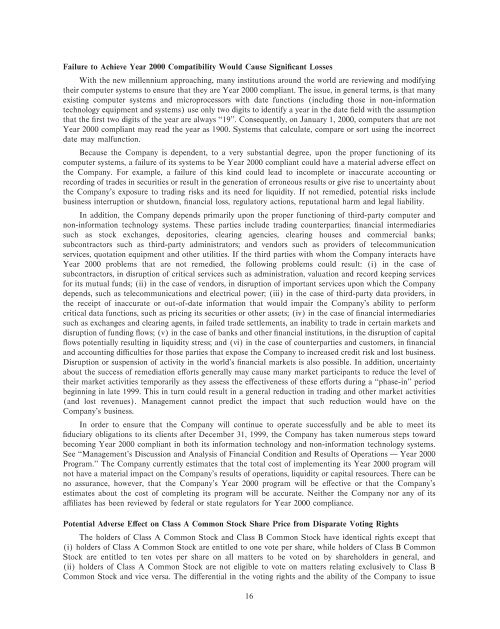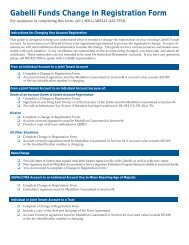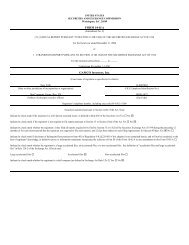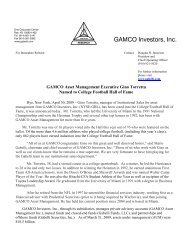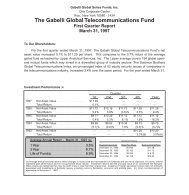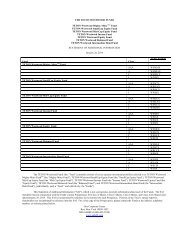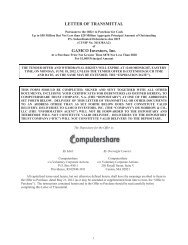Original GBL Prospectus - Gabelli
Original GBL Prospectus - Gabelli
Original GBL Prospectus - Gabelli
Create successful ePaper yourself
Turn your PDF publications into a flip-book with our unique Google optimized e-Paper software.
Failure to Achieve Year 2000 Compatibility Would Cause SigniÑcant Losses<br />
With the new millennium approaching, many institutions around the world are reviewing and modifying<br />
their computer systems to ensure that they are Year 2000 compliant. The issue, in general terms, is that many<br />
existing computer systems and microprocessors with date functions (including those in non-information<br />
technology equipment and systems) use only two digits to identify a year in the date Ñeld with the assumption<br />
that the Ñrst two digits of the year are always ""19''. Consequently, on January 1, 2000, computers that are not<br />
Year 2000 compliant may read the year as 1900. Systems that calculate, compare or sort using the incorrect<br />
date may malfunction.<br />
Because the Company is dependent, to a very substantial degree, upon the proper functioning of its<br />
computer systems, a failure of its systems to be Year 2000 compliant could have a material adverse eÅect on<br />
the Company. For example, a failure of this kind could lead to incomplete or inaccurate accounting or<br />
recording of trades in securities or result in the generation of erroneous results or give rise to uncertainty about<br />
the Company's exposure to trading risks and its need for liquidity. If not remedied, potential risks include<br />
business interruption or shutdown, Ñnancial loss, regulatory actions, reputational harm and legal liability.<br />
In addition, the Company depends primarily upon the proper functioning of third-party computer and<br />
non-information technology systems. These parties include trading counterparties; Ñnancial intermediaries<br />
such as stock exchanges, depositories, clearing agencies, clearing houses and commercial banks;<br />
subcontractors such as third-party administrators; and vendors such as providers of telecommunication<br />
services, quotation equipment and other utilities. If the third parties with whom the Company interacts have<br />
Year 2000 problems that are not remedied, the following problems could result: (i) in the case of<br />
subcontractors, in disruption of critical services such as administration, valuation and record keeping services<br />
for its mutual funds; (ii) in the case of vendors, in disruption of important services upon which the Company<br />
depends, such as telecommunications and electrical power; (iii) in the case of third-party data providers, in<br />
the receipt of inaccurate or out-of-date information that would impair the Company's ability to perform<br />
critical data functions, such as pricing its securities or other assets; (iv) in the case of Ñnancial intermediaries<br />
such as exchanges and clearing agents, in failed trade settlements, an inability to trade in certain markets and<br />
disruption of funding Öows; (v) in the case of banks and other Ñnancial institutions, in the disruption of capital<br />
Öows potentially resulting in liquidity stress; and (vi) in the case of counterparties and customers, in Ñnancial<br />
and accounting diÇculties for those parties that expose the Company to increased credit risk and lost business.<br />
Disruption or suspension of activity in the world's Ñnancial markets is also possible. In addition, uncertainty<br />
about the success of remediation eÅorts generally may cause many market participants to reduce the level of<br />
their market activities temporarily as they assess the eÅectiveness of these eÅorts during a ""phase-in'' period<br />
beginning in late 1999. This in turn could result in a general reduction in trading and other market activities<br />
(and lost revenues). Management cannot predict the impact that such reduction would have on the<br />
Company's business.<br />
In order to ensure that the Company will continue to operate successfully and be able to meet its<br />
Ñduciary obligations to its clients after December 31, 1999, the Company has taken numerous steps toward<br />
becoming Year 2000 compliant in both its information technology and non-information technology systems.<br />
See ""Management's Discussion and Analysis of Financial Condition and Results of Operations Ì Year 2000<br />
Program.'' The Company currently estimates that the total cost of implementing its Year 2000 program will<br />
not have a material impact on the Company's results of operations, liquidity or capital resources. There can be<br />
no assurance, however, that the Company's Year 2000 program will be eÅective or that the Company's<br />
estimates about the cost of completing its program will be accurate. Neither the Company nor any of its<br />
aÇliates has been reviewed by federal or state regulators for Year 2000 compliance.<br />
Potential Adverse EÅect on Class A Common Stock Share Price from Disparate Voting Rights<br />
The holders of Class A Common Stock and Class B Common Stock have identical rights except that<br />
(i) holders of Class A Common Stock are entitled to one vote per share, while holders of Class B Common<br />
Stock are entitled to ten votes per share on all matters to be voted on by shareholders in general, and<br />
(ii) holders of Class A Common Stock are not eligible to vote on matters relating exclusively to Class B<br />
Common Stock and vice versa. The diÅerential in the voting rights and the ability of the Company to issue<br />
16


